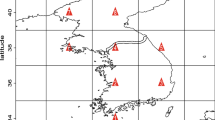Abstract
Bayesian model averaging (BMA) is a recently proposed statistical method for calibrating forecast ensembles from numerical weather models. However, successful implementation of BMA requires accurate estimates of the weights and variances of the individual competing models in the ensemble. Two methods, namely the Expectation-Maximization (EM) and the Markov Chain Monte Carlo (MCMC) algorithms, are widely used for BMA model training. Both methods have their own respective strengths and weaknesses. In this paper, we first modify the BMA log-likelihood function with the aim of removing the additional limitation that requires that the BMA weights add to one, and then use a limited memory quasi-Newtonian algorithm for solving the nonlinear optimization problem, thereby formulating a new approach for BMA (referred to as BMA-BFGS). Several groups of multi-model soil moisture simulation experiments from three land surface models show that the performance of BMA-BFGS is similar to the MCMC method in terms of simulation accuracy, and that both are superior to the EM algorithm. On the other hand, the computational cost of the BMA-BFGS algorithm is substantially less than for MCMC and is almost equivalent to that for EM.
Similar content being viewed by others
References
Barnston A G, Mason S J, Goddard L, et al. Multimodel ensembling in seasonal climate forecasting at IRI. Bull Am Meteorol Soc, 2003, 84: 1783–1796
Grimitt E P, Mass C F. Initial results of a mesoscale short-range ensemble forecasting system over the Pacific Northwest. Weather Forecast, 2002, 17: 192–205
Molteni F, Buizza R, Palmer T N, et al. The ECWMF ensemble prediction system: Methodology and validation. Q J R Meteorol Soc 1996, 122: 73–119
Palmer T N, Alessandri A, Andersen U, et al. Development of a European Multi-model ensemble system for seasonal-to-interannual prediction (DEMETER). Bull Am Meteorol Soc, 2004, 85: 853–872
Raftery A E, Gneiting T, Balabdaoui F, et al. Using Bayesian model averaging to calibrate forecast ensembles. Mon Weather Rev, 2005, 133: 1155–1174
Ajami N K, Duan Q, Sorooshian S. An integrated hydrologic Bayesian multimodel combination framework: confronting input, parameter, and model structural uncertainty in hydrologic prediction. Water Resour Res, 2007, 43: W01403
Neuman S P. Maximum likelihood Bayesian averaging of uncertain model predictions. Stoch Environ Res Risk Assess, 2003, 17: 291–305
Raftery A E, Madigan D, Hoeting J A. Bayesian model averaging for linear regression models. J Am Stat Assoc, 1997, 92: 179–191
Sloughter J M, Raftery A E, Gneiting T. Probabilistic quantitative precipitation forecasting using Bayesian model averaging. University of Washington, Department of Statistics, Technical Report 496, Seattle, W A, 2006. 20
Xie H, Eheart J W, Chen Y, et al. An approach for improving the sampling efficiency in the Bayesian calibration of computationally expensive simulation models. Water Resour Res, 2009, 45: W06419
Liu J S, Liang F, Wong W H. The multiple-try method and local optimization in metropolis sampling. J Am Stat Assoc, 2000, 95: 121–134
Byrd R H, Lu P, Nocedal J, et al. A limited memory algorithm for bound constrained optimization, SIAM J. Sci Compu, 1995, 16: 1190–1208
Zhu C, Byrd R H, Lu P, et al. L-BFGS-B: A limited memory FORTRAN code for solving bound constrained optimization problems, Tech Report, NAM-11, EECS Department, Northwestern University, 1994
Oleson, K W, Niu G Y, Yang Z L, et al. Improvements to the community land model and their impact on the hydrological cycle. J Geophys Res, 2008, 113: G01021
Wang A, Li K Y, Lettenmaier D P. Integration of the variable infiltration capacity model soil hydrology scheme into the community land model. J Geophys Res, 2008, 113: D09111
Schaake, J C, Koren V I, Duan Q Y, et al. Simple water balance model for estimating runoff at different spatial and temporal scales. J Geophys Res, 1996, 101: 7461–7475
Chen F, Janjic Z, Mitchell K. Impact of atmospheric surface layer parameterizations in the new land-surface scheme of the NCEP mesoscale Eta model. Bound-Lay Meteorol, 1997, 85: 391–421
Ek M B, Mitchell K E, Lin Y, et al. Implementation of Noah land surface model advances in the National Centers for Environmental Prediction operational mesoscale Eta model. J Geophys Res, 2003, 108, doi: 10.1029/2002JD003296
Sheffield J, Goteti G, Wood E F. Development of a 50-year high-resolution global dataset of meteorological forcings for land surface modeling. J Clim, 2006, 19: 3088–3111
Wang A, Bohn T J, Mahanama S P, et al. Multi-model ensemble reconstruction of drought over the continental United States. J Clim, 2009, 22: 2694–2712
Tian X J, Xie Z H, Dai A G, et al. A dual-pass variational data assimilation framework for estimating soil moisture profiles from AMSR-E microwave brightness temperature. J Geophys Res, 2009, 114: D16102
Tian X J, Xie Z H, Dai A G, et al. A microwave land data assimilation system: Scheme and preliminary evaluation over China. J Geophys Res, 2010, 115: D21113
Author information
Authors and Affiliations
Corresponding author
Rights and permissions
About this article
Cite this article
Tian, X., Xie, Z., Wang, A. et al. A new approach for Bayesian model averaging. Sci. China Earth Sci. 55, 1336–1344 (2012). https://doi.org/10.1007/s11430-011-4307-x
Received:
Accepted:
Published:
Issue Date:
DOI: https://doi.org/10.1007/s11430-011-4307-x




